AMD FX-8370E CPU Review: Vishera Down to 95W, Price Cuts for FX
by Ian Cutress on September 2, 2014 8:00 AM ESTCPU Benchmarks
The dynamics of CPU Turbo modes, with both Intel and AMD, can cause concern during environments with a variable threaded workload. There is also an added issue of the motherboard remaining consistent, depending on how the motherboard manufacturer wants to add in their own boosting technologies over the ones that Intel would prefer they used. In order to remain consistent, we implement an OS-level unique high performance mode on all the CPUs we test which should override any motherboard manufacturer performance mode.
HandBrake v0.9.9: link
For HandBrake, we take two videos (a 2h20 640x266 DVD rip and a 10min double UHD 3840x4320 animation short) and convert them to x264 format in an MP4 container. Results are given in terms of the frames per second processed, and HandBrake uses as many threads as possible.
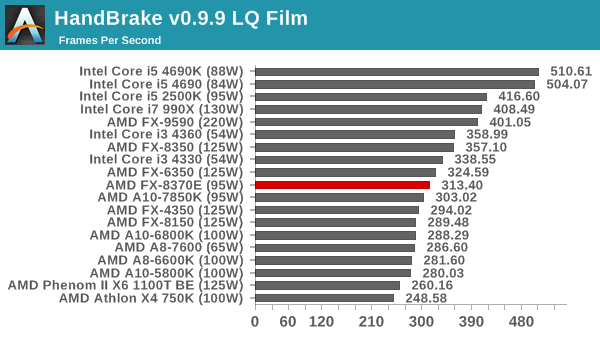
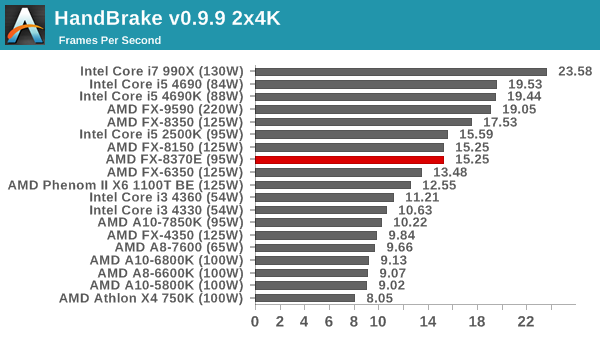
Handbrake balances cores and frequency, with the LQ film test often condensing CPUs based on frequency and the double UHD test expanding by cores. The double UHD test puts the 8370E at the bottom of the AMD 8-thread CPUs as expected.
Agisoft Photoscan – 2D to 3D Image Manipulation: link
Agisoft Photoscan creates 3D models from 2D images, a process which is very computationally expensive. The algorithm is split into four distinct phases, and different phases of the model reconstruction require either fast memory, fast IPC, more cores, or even OpenCL compute devices to hand. Agisoft supplied us with a special version of the software to script the process, where we take 50 images of a stately home and convert it into a medium quality model. This benchmark typically takes around 15-20 minutes on a high end PC on the CPU alone, with GPUs reducing the time.
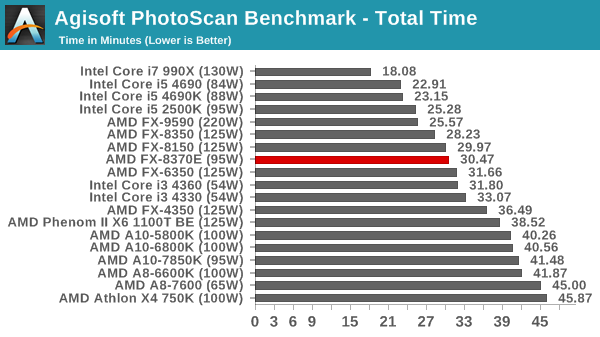
Photoscan results seem to take the following order: i7, i5, FX (8), FX (6), i3, FX (4), A10, A8. The 8370E sits at the bottom of the FX 8-thread section as before.
WinRAR 5.0.1: link

WinRAR takes advantage of all the AMD threads due to its integer workloads.
PCMark8 v2 OpenCL
A new addition to our CPU testing suite is PCMark8 v2, where we test the Work 2.0 and Creative 3.0 suites in OpenCL mode. As this test is new, we have not run it on many AMD systems yet and will do so as soon as we can.

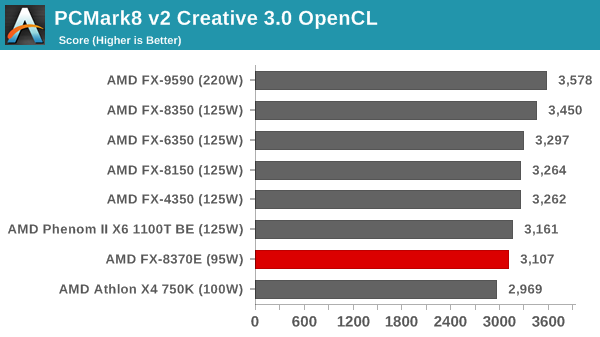
The PCMark8 tests both seem to favor frequency at this point, with the FX-9590 taking the lead.
Hybrid x265
Hybrid is a new benchmark, where we take a 4K 1500 frame video and convert it into an x265 format without audio. Results are given in frames per second.
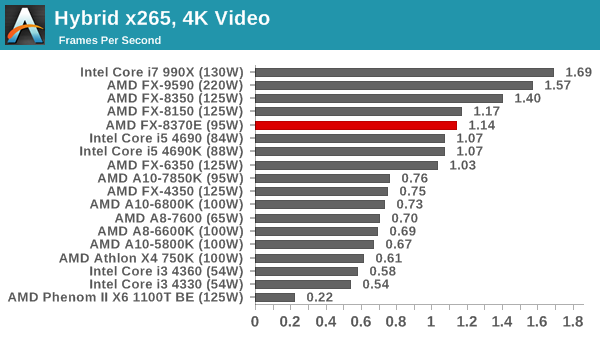
Again, more threads gives an intesting workload. The FX-8370E beats out the i5-4690K as well.
Cinebench R15
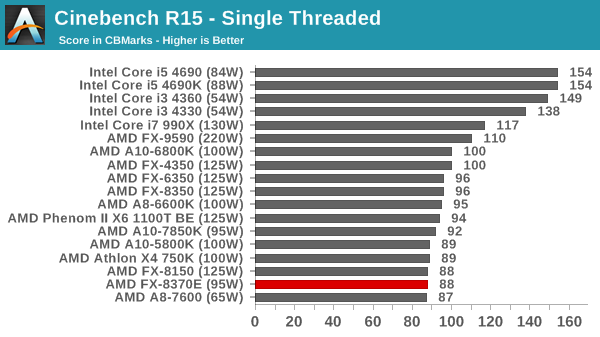

Unfortunately the Achilles heel strikes again in single threaded performance. Multithreaded puts it just behind the FX-8150.
3D Particle Movement
3DPM is a self-penned benchmark, taking basic 3D movement algorithms used in Brownian Motion simulations and testing them for speed. High floating point performance, MHz and IPC wins in the single thread version, whereas the multithread version has to handle the threads and loves more cores.

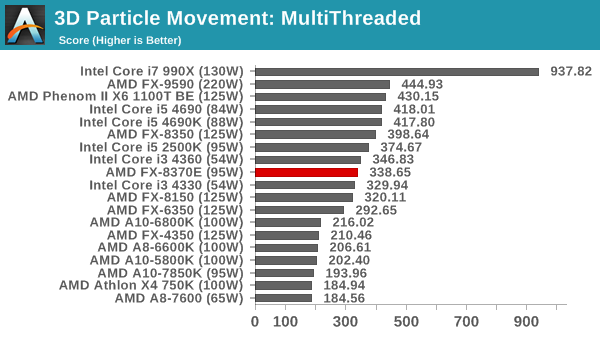
FastStone Image Viewer 4.9
FastStone is the program I use to perform quick or bulk actions on images, such as resizing, adjusting for color and cropping. In our test we take a series of 170 images in various sizes and formats and convert them all into 640x480 .gif files, maintaining the aspect ratio. FastStone does not use multithreading for this test, and results are given in seconds.
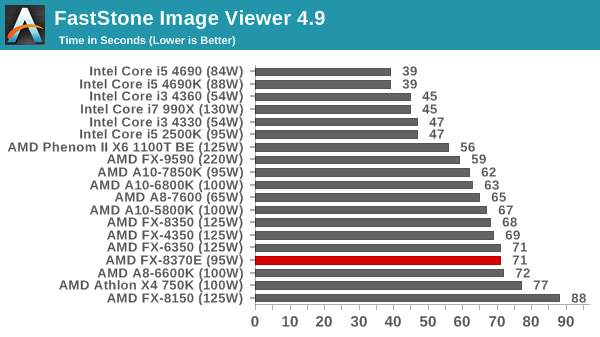
Web Benchmarks
On the lower end processors, general usability is a big factor of experience, especially as we move into the HTML5 era of web browsing. For our web benchmarks, we take four well known tests with Chrome 35 as a consistent browser.
Sunspider 1.0.2
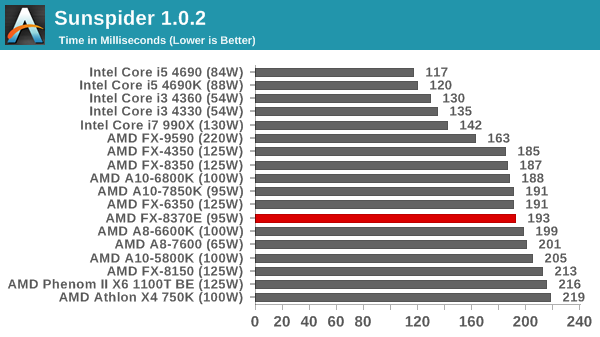
Mozilla Kraken 1.1
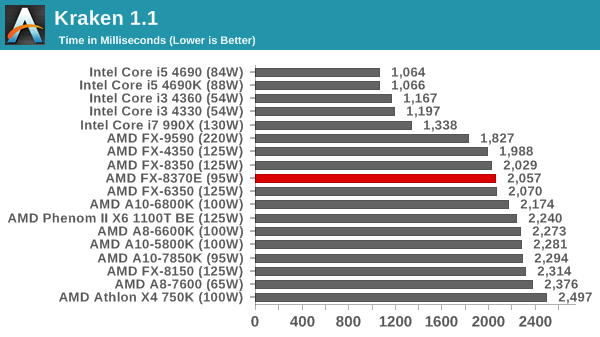
WebXPRT
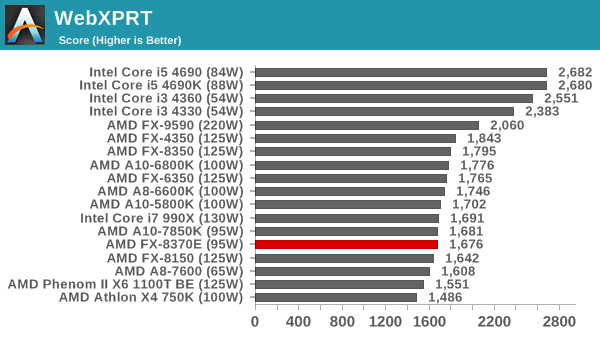
Google Octane v2
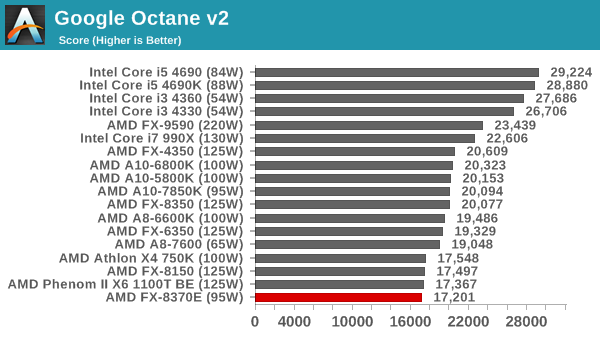










107 Comments
View All Comments
Germanicus - Tuesday, September 2, 2014 - link
Everyone has different ethics. Not trolling.Most everyone here is parroting the same points. This isn't adding anything to the discussion. It is a bash-fest.
Germanicus - Tuesday, September 2, 2014 - link
Fawn? Whatever. Never implied that. I wish they were more competitive.silverblue - Tuesday, September 2, 2014 - link
These sorts of chips do rather well in multithreaded workloads. Most games really don't fit this category yet.I'd get the 8320E over this any day though - there's a rather uncomfortable price difference despite what should be very similar performance. Still, an eight-core Steamroller clocked at even 8320 (125W edition) speeds would outperform pretty much all of AMD's FX line and use less power, but I imagine not by quite enough to warrant its release.
bsim500 - Tuesday, September 2, 2014 - link
"These sorts of chips do rather well in multithreaded workloads. Most games really don't fit this category yet."That's the problem word - "yet". AMD has spent the last 5 years endlessly waiting for "the day after tomorrow's games" instead of giving people what they want today : +50-70% faster cores (which runs all software faster multi-threaded or not) just to close the gap with Intel...
duploxxx - Wednesday, September 3, 2014 - link
did you also care to look at multithreaded benchmarks where the 54W get trashed everywhere..multithreading is still the future and you just put yourself back to 2009 and earlier, but hey you do run a few fps faster which you can't even notice within the game :).
beginner99 - Tuesday, September 2, 2014 - link
My 5 year old 45 nm Lynnfield is faster single-threaded than this thing. OMG.just4U - Tuesday, September 2, 2014 - link
According to bench.. it's somewhat above Intel's core2 8x and just below their first i5/3s.TiGr1982 - Tuesday, September 2, 2014 - link
Which is not surprising, because Piledriver is slower at the same clocks than Core 2, let alone any Core i7.MrSpadge - Tuesday, September 2, 2014 - link
Alright, AMD made it clear they don't think it's worth to upgrade their CPUs to their current architecture (they already have the cores) and at least 28 nm manufacturing (cheaper per transistor). And they could be right in that people just wouldn't buy enough of these to make up for the development costs.So they try to make the best use of what they have. Yet.. do they? I could imagine them doing something much better with 4-module Piledriver dies: put 2 of them onto the same package, like they do for Opterons! Sell them at decent prices and anyone wanting cheap multithread number crunchers might be interested. They might hurt 1 and 2 socket Opteron sales a bit.. but without any updates, how competitive are they anyway? And you can't put much RAM into desktop boards anyway, so this wouldn't be that much of a thread.
TiGr1982 - Tuesday, September 2, 2014 - link
Two dies won't fit in AM3+; so what you suggest is rebranding the socket G34 for a desktop and selling it cheaper, I suppose. Still a questionable idea IMHO to me.